Nikolai Gogol
Nikolai Gogol | |
|---|---|
 Daguerreotype of Gogol taken in 1845 by Sergei Lvovich Levitsky (1819–1898) | |
| Born | Nikolai Vasilievich Gogol-Yanovsky 20 March 1809[1] (OS)/1 April 1809 (NS) Sorochyntsi, Poltava Governorate, Russian Empire |
| Died | 21 February 1852 (aged 42) Moscow, Russian Empire |
| Resting place | Novodevichy Cemetery |
| Occupation | Playwright, short story writer, novelist |
| Language | Ukrainian and Russian |
| Nationality | Ukrainian |
| Citizenship | Russian Empire |
| Period | 1840–51 |
| Signature |  |
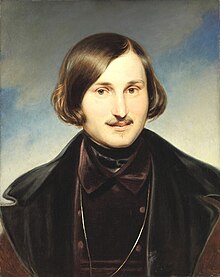
Nikolai Vasilyevich Gogol (/ˈɡoʊɡəl, ˈɡoʊɡɔːl/;[2] Russian: Никола́й Васи́льевич Го́голь, tr. Nikolay Vasil'yevich Gogol', IPA: [nʲɪkɐˈlaj vɐˈsʲilʲjɪvʲɪdʑ ˈɡoɡəlʲ]; Ukrainian: Мико́ла Васи́льович Го́голь, romanized: Mykola Vasyl'ovych Hohol'; 1 April [O.S. 20 March] 1809[1] – 4 March [O.S. 21 February] 1852) was a Russian[3][4][5][6][7] novelist, short story writer and playwright of Ukrainian origin.[8][9][10][11][12][13]
Gogol was one of the first to use the techniques of surrealism and the grotesque in his works ("The Nose", "Viy", "The Overcoat", "Nevsky Prospekt"). Kornelije Kvas wrote that "the logical construction of Gogol’s The Petersburg Tales remains realistic, for the grotesque and fantastic elements fit in with the realistic matrix of events, following the logic of events that is close to the regularity of the unfolding of events in the reality that is accessible to us".[14] According to Viktor Shklovsky, the strange style of writing that Gogol used is more like the "ostranenie" technique.[15] His early works, such as Evenings on a Farm Near Dikanka, were influenced by his Ukrainian upbringing, Ukrainian culture and folklore.[16][17] His later writing satirised political corruption in the Russian Empire (The Government Inspector, Dead Souls). The novel Taras Bulba (1835) and the play Marriage (1842), along with the short stories "Diary of a Madman", "The Tale of How Ivan Ivanovich Quarreled with Ivan Nikiforovich", "The Portrait" and "The Carriage", are also among his best-known works.
According to Vissarion Belinsky and Nikolay Chernyshevsky, Gogol had a huge influence on Russian and world literature. Gogol's influence was acknowledged by Mikhail Bulgakov, Fyodor Dostoevsky, Ryūnosuke Akutagawa, Flannery O'Connor, Franz Kafka and others.[18][19]
Early life[]
Gogol was born in the Ukrainian Cossack town of Sorochyntsi,[20] in the Poltava Governorate of the Russian Empire. His mother descended from Leonty Kosyarovsky, an officer of the Lubny Regiment in 1710. His father Vasily Gogol-Yanovsky, a descendant of Ukrainian Cossacks (see Lyzohub family) who died when Gogol was 15 years old, belonged to the 'petty gentry', wrote poetry in Ukrainian and Russian, and was an amateur Ukrainian-language playwright. As was typical of the left-bank Ukrainian gentry of the early nineteenth century, the family spoke Ukrainian as well as Russian. As a child, Gogol helped stage Ukrainian-language plays in his uncle's home theater.[21]
In 1820, Gogol went to a school of higher art in Nizhyn (now Nizhyn Gogol State University) and remained there until 1828. It was there that he began writing. He was not popular among his schoolmates, who called him their "mysterious dwarf", but with two or three of them he formed lasting friendships. Very early he developed a dark and secretive disposition, marked by a painful self-consciousness and boundless ambition. Equally early he developed a talent for mimicry, which later made him a matchless reader of his own works and induced him to toy with the idea of becoming an actor.
In 1828, on leaving school, Gogol came to Saint Petersburg, full of vague but glowingly ambitious hopes. He had hoped for literary fame, and brought with him a Romantic poem of German idyllic life – Hans Küchelgarten. He had it published, at his own expense, under the name of "V. Alov." The magazines he sent it to almost universally derided it. He bought all the copies and destroyed them, swearing never to write poetry again.
Gogol was in touch with the "literary aristocracy", had a story published in Anton Delvig's Northern Flowers, was taken up by Vasily Zhukovsky and Pyotr Pletnyov, and (in 1831) was introduced to Pushkin.
Literary development[]
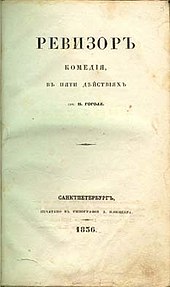
In 1831, Gogol brought out the first volume of his Ukrainian stories (Evenings on a Farm Near Dikanka), which met with immediate success.[22] He followed it in 1832 with a second volume, and in 1835 by two volumes of stories entitled Mirgorod, as well as by two volumes of miscellaneous prose entitled Arabesques. At this time, Russian editors and critics such as Nikolai Polevoy and Nikolai Nadezhdin saw in Gogol the emergence of a Ukrainian, rather than Russian, writer, using his works to illustrate the differences between Russian and Ukrainian national characters.[23] The themes and style of these early prose works by Gogol, as well as his later drama, were similar to the work of Ukrainian writers and dramatists who were his contemporaries and friends, including Hryhory Kvitka-Osnovyanenko and Vasily Narezhny. However, Gogol's satire was much more sophisticated and unconventional.[24]
At this time, Gogol developed a passion for Ukrainian history and tried to obtain an appointment to the history department at Kyiv University. Despite the support of Pushkin and Sergey Uvarov, the Russian minister of education, his appointment was blocked by a Kyivan bureaucrat on the grounds that Gogol was unqualified.[25] His fictional story Taras Bulba, based on the history of Ukrainian cossacks, was the result of this phase in his interests. During this time, he also developed a close and lifelong friendship with another Ukrainian, the historian and naturalist Mykhaylo Maksymovych.[26]
In 1834, Gogol was made Professor of Medieval History at the University of St. Petersburg, a job for which he had no qualifications. "He turned in a performance ludicrous enough to warrant satiric treatment in one of his own stories. After an introductory lecture made up of brilliant generalizations which the 'historian' had prudently prepared and memorized, he gave up all pretence at erudition and teaching, missed two lectures out of three, and when he did appear, muttered unintelligibly through his teeth. At the final examination, he sat in utter silence with a black handkerchief wrapped around his head, simulating a toothache, while another professor interrogated the students."[27] This academic venture proved a failure and he resigned his chair in 1835.
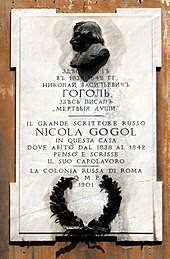
Between 1832 and 1836, Gogol worked with great energy, and though almost all his work has in one way or another its sources in these four years of contact with Pushkin, he had not yet decided that his ambitions were to be fulfilled by success in literature. During this time, the Russian critics Stepan Shevyrev and Vissarion Belinsky, contradicting earlier critics, reclassified Gogol from a Ukrainian to a Russian writer.[23] It was only after the presentation at the Saint Petersburg State Theatre, on 19 April 1836, of his comedy The Government Inspector (Revizor)[28] that he finally came to believe in his literary vocation. The comedy, a violent satire of Russian provincial bureaucracy, was staged thanks only to the intervention of the emperor, Nicholas I.
From 1836 to 1848, Gogol lived abroad, travelling through Germany and Switzerland. Gogol spent the winter of 1836–37 in Paris,[29] among Russian expatriates and Polish exiles, frequently meeting the Polish poets Adam Mickiewicz and Bohdan Zaleski. He eventually settled in Rome. For much of the twelve years from 1836, Gogol was in Italy developing an adoration for Rome. He studied art, read Italian literature and developed a passion for opera.
Pushkin's death produced a strong impression on Gogol. His principal work during the years following Pushkin's death was the satirical epic Dead Souls. Concurrently, he worked at other tasks – recast Taras Bulba (1842)[30] and The Portrait, completed his second comedy, Marriage (Zhenitba), wrote the fragment and his most famous short story, "The Overcoat".
In 1841, the first part of Dead Souls was ready, and Gogol took it to Russia to supervise its printing. It appeared in Moscow in 1842, under the title, imposed by the censorship, of The Adventures of Chichikov. The book instantly established his reputation as the greatest prose writer in the language.
Creative decline and death[]
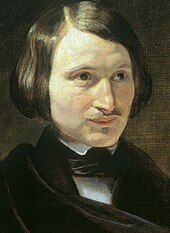
After the triumph of Dead Souls, Gogol's contemporaries came to regard him as a great satirist who lampooned the unseemly sides of Imperial Russia. Little did they know that Dead Souls was but the first part of a planned modern-day counterpart to the Divine Comedy of Dante.[citation needed] The first part represented the Inferno; the second part would depict the gradual purification and transformation of the rogue Chichikov under the influence of virtuous publicans and governors – Purgatory.[31]
In April 1848, Gogol returned to Russia from a pilgrimage to Jerusalem and passed his last years in restless movement throughout the country. While visiting the capitals, he stayed with friends such as Mikhail Pogodin and Sergey Aksakov. During this period, he also spent much time with his old Ukrainian friends, Maksymovych and Osyp Bodiansky. He intensified his relationship with a starets or spiritual elder, Matvey Konstantinovsky, whom he had known for several years. Konstantinovsky seems to have strengthened in Gogol the fear of perdition (damnation) by insisting on the sinfulness of all his imaginative work. Exaggerated ascetic practices undermined his health and he fell into a state of deep depression. On the night of 24 February 1852 he burned some of his manuscripts, which contained most of the second part of Dead Souls. He explained this as a mistake, a practical joke played on him by the Devil.[citation needed] Soon thereafter, he took to bed, refused all food, and died in great pain nine days later.
Gogol was mourned in the Saint Tatiana church at the Moscow University before his burial and then buried at the Danilov Monastery, close to his fellow Slavophile Aleksey Khomyakov. His grave was marked by a large stone (Golgotha), topped by a Russian Orthodox cross.[32] In 1931, Moscow authorities decided to demolish the monastery and had Gogol's remains transferred to the Novodevichy Cemetery.[33]

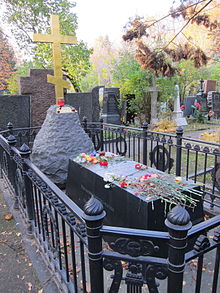
His body was discovered lying face down, which gave rise to the story that Gogol had been buried alive. The authorities moved the Golgotha stone to the new gravesite, but removed the cross; in 1952 the Soviets replaced the stone with a bust of Gogol. The stone was later reused for the tomb of Gogol's admirer Mikhail Bulgakov. In 2009, in connection with the bicentennial of Gogol's birth, the bust was moved to the museum at Novodevichy Cemetery, and the original Golgotha stone was returned, along with a copy of the original Orthodox cross.[34]
The first Gogol monument in Moscow, a Symbolist statue on Arbat Square, represented the sculptor Nikolay Andreyev's idea of Gogol rather than the real man.[35] Unveiled in 1909, the statue received praise from Ilya Repin and from Leo Tolstoy as an outstanding projection of Gogol's tortured personality. Joseph Stalin did not like it, however, and the statue was replaced by a more orthodox Socialist Realism monument in 1952. It took enormous efforts to save Andreyev's original work from destruction; as of 2014 it stands in front of the house where Gogol died.[36]
Style[]

D. S. Mirsky characterized Gogol's universe as "one of the most marvellous, unexpected – in the strictest sense, original[37] – worlds ever created by an artist of words".[38]
The other main characteristic of Gogol's writing is his 'impressionist' vision of reality and people.[citation needed] He saw the outer world strangely metamorphosed, a singular gift particularly evident from the fantastic spatial transformations in his Gothic stories, "A Terrible Vengeance" and "A Bewitched Place". His pictures of nature are strange mounds of detail heaped on detail, resulting in an unconnected chaos of things. His people are caricatures, drawn with the method of the caricaturist – which is to exaggerate salient features and to reduce them to geometrical pattern. But these cartoons have a convincingness, a truthfulness, and inevitability – attained as a rule by slight but definitive strokes of unexpected reality – that seems to beggar the visible world itself.[39][need quotation to verify] According to Andrey Bely, Gogol's work influenced the emergence of Gothic romance, and served as a forerunner for absurdism and impressionism.[40]
The aspect under which the mature Gogol sees reality is expressed by the Russian word poshlost', which means something similar to "triviality, banality, inferiority", moral and spiritual, widespread in some group or society. Like Sterne before him, Gogol was a great destroyer of prohibitions and of romantic illusions. He undermined Russian Romanticism by making vulgarity reign where only the sublime and the beautiful had before.[41] "Characteristic of Gogol is a sense of boundless superfluity that is soon revealed as utter emptiness and a rich comedy that suddenly turns into metaphysical horror."[42] His stories often interweave pathos and mockery, while "The Tale of How Ivan Ivanovich Quarreled with Ivan Nikiforovich" begins as a merry farce and ends with the famous dictum, "It is dull in this world, gentlemen!"
Politics[]
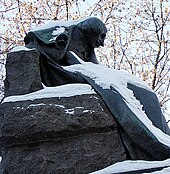
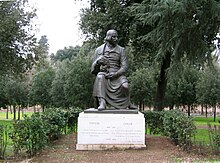


It stunned Gogol when critics interpreted The Government Inspector as an indictment of tsarism despite Nicholas I's patronage of the play. Gogol himself, an adherent of the Slavophile movement, believed in a divinely inspired mission for both the House of Romanov and the Russian Orthodox Church. Like Fyodor Dostoyevsky, Gogol sharply disagreed with those Russians who preached constitutional monarchy and the disestablishment of the Orthodox Church.
After defending autocracy, serfdom, and the Orthodox Church in his book Selected Passages from Correspondence with his Friends (1847), Gogol came under attack from his former patron Vissarion Belinsky. The first Russian intellectual to publicly preach the economic theories of Karl Marx, Belinsky accused Gogol of betraying his readership by defending the status quo.[43]
Influence and interpretations[]
Even before the publication of Dead Souls, Belinsky recognized Gogol as the first Russian-language realist writer and as the head of the Natural School, to which he also assigned such younger or lesser authors as Goncharov, Turgenev, Dmitry Grigorovich, Vladimir Dahl and Vladimir Sollogub. Gogol himself appeared skeptical about the existence of such a literary movement. Although he recognized "several young writers" who "have shown a particular desire to observe real life", he upbraided the deficient composition and style of their works.[44] Nevertheless, subsequent generations of radical critics celebrated Gogol (the author in whose world a nose roams the streets of the Russian capital) as a great realist, a reputation decried by the Encyclopædia Britannica as "the triumph of Gogolesque irony".[45]
The period of literary modernism saw a revival of interest in and a change of attitude towards Gogol's work. One of the pioneering works of Russian formalism was Eichenbaum's reappraisal of "The Overcoat". In the 1920s a group of Russian short-story writers, known as the Serapion Brothers, placed Gogol among their precursors and consciously sought to imitate his techniques. The leading novelists of the period – notably Yevgeny Zamyatin and Mikhail Bulgakov – also admired Gogol and followed in his footsteps. In 1926 Vsevolod Meyerhold staged The Government Inspector as a "comedy of the absurd situation", revealing to his fascinated spectators a corrupt world of endless self-deception. In 1934 Andrei Bely published the most meticulous study of Gogol's literary techniques up to that date, in which he analyzed the colours prevalent in Gogol's work depending on the period, his impressionistic use of verbs, the expressive discontinuity of his syntax, the complicated rhythmical patterns of his sentences, and many other secrets of his craft. Based on this work, Vladimir Nabokov published a summary account of Gogol's masterpieces.[46]
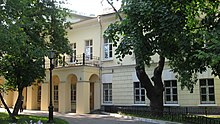
Gogol's impact on Russian literature has endured, yet various critics have appreciated his works differently. Belinsky, for instance, berated his horror stories as "moribund, monstrous works", while Andrei Bely counted them among his most stylistically daring creations. Nabokov especially admired Dead Souls, The Government Inspector, and "The Overcoat" as works of genius, proclaiming that "when, as in his immortal 'The Overcoat', Gogol really let himself go and pottered happily on the brink of his private abyss, he became the greatest artist that Russia has yet produced."[47] Critics traditionally interpreted "The Overcoat" as a masterpiece of "humanitarian realism", but Nabokov and some other attentive readers argued that "holes in the language" make the story susceptible to interpretation as a supernatural tale about a ghostly double of a "small man".[48] Of all Gogol's stories, "The Nose" has stubbornly defied all abstruse interpretations: D.S. Mirsky declared it "a piece of sheer play, almost sheer nonsense". In recent years, however, "The Nose" became the subject of several interesting postmodernist and postcolonial interpretations.
Gogol's oeuvre has also had a large impact on Russia's non-literary culture, and his stories have been adapted numerous times into opera and film. The Russian composer Alfred Schnittke wrote the eight-part Gogol Suite as incidental music to The Government Inspector performed as a play, and Dmitri Shostakovich set The Nose as his first opera in 1928 – a peculiar choice of subject for what was meant[by whom?] to initiate the great tradition of Soviet opera.[49] More recently, to celebrate the 200th anniversary of Gogol's birth in 1809, Vienna's renowned Theater an der Wien commissioned music and libretto for a full-length opera on the life of Gogol from Russian composer and writer Lera Auerbach.[50]
Some critics have paid attention to the apparent anti-Semitism in Gogol's writings, as well as in those of his contemporary, Fyodor Dostoyevsky.[51] Felix Dreizin and David Guaspari, for example, in their The Russian Soul and the Jew: Essays in Literary Ethnocentrism, discuss "the significance of the Jewish characters and the negative image of the Ukrainian Jewish community in Gogol's novel Taras Bulba, pointing out Gogol's attachment to anti-Jewish prejudices prevalent in Russian and Ukrainian culture."[52] In Léon Poliakov's The History of Antisemitism, the author mentions that
"The 'Yankel' from Taras Bulba indeed became the archetypal Jew in Russian literature. Gogol painted him as supremely exploitative, cowardly, and repulsive, albeit capable of gratitude. But it seems perfectly natural in the story that he and his cohorts be drowned in the Dniper by the Cossack lords. Above all, Yankel is ridiculous, and the image of the plucked chicken that Gogol used has made the rounds of great Russian authors."[53]
Despite his portrayal of Jewish characters, Gogol left a powerful impression even on Jewish writers who inherited his literary legacy. Amelia Glaser has noted the influence of Gogol's literary innovations on Sholem Aleichem, who
"chose to model much of his writing, and even his appearance, on Gogol... What Sholem Aleichem was borrowing from Gogol was a rural East European landscape that may have been dangerous, but could unite readers through the power of collective memory. He also learned from Gogol to soften this danger through laughter, and he often rewrites Gogol's Jewish characters, correcting anti-Semitic stereotypes and narrating history from a Jewish perspective."[54]
Adaptations[]
BBC Radio 4 made a series of six Gogol short stories, entitled Three Ivans, Two Aunts and an Overcoat (2002, adaptations by Jim Poyser) starring Griff Rhys-Jones and Stephen Moore. The stories adapted were "The Two Ivans", "The Overcoat", "Ivan Fyodorovich Shponka and His Aunt", "The Nose", "The Mysterious Portrait" and "Diary of a Madman".
Gogol's short story "Christmas Eve" was adapted into operatic form twice by Tchaikovsky, first as Vakula the Smith in 1874, then as The Tsarina's Slippers in 1885; Rimsky-Korsakov also wrote an opera based on the same story in 1894. The story was also adapted for radio by and broadcast on BBC Radio 4 on 24 December 2008[55] and subsequently rebroadcast on both Radio 4 and Radio 4 Extra on Christmas Eve 2010, 2011 and 2015;[56]
The short story "Christmas Eve" was also adapted into a film in 1961 entitled The Night Before Christmas.
Gogol's story "Viy" was adapted into film by Russian filmmakers four times: the original Viy in 1967; the horror film Vedma (aka The Power of Fear) in 2006; the action-horror film Viy in 2014; and the horror film Gogol Viy released in 2018. It was also adapted into the Russian FMV video game Viy: The Story Retold (2004). Outside of Russia, the film loosely served as the inspiration for Mario Bava's film Black Sunday (1960) and the South Korean horror film Evil Spirit: Viy (2008).
Gogol's short story "The Portrait" is being made into a feature film The Portrait by fine artists Anastasia Elena Baranoff and Elena Vladimir Baranoff.[57][58][59][60][61][62]
The Russian TV-3 television series Gogol features Nikolai Gogol as a lead character and presents a fictionalized version of his life that mixes his history with elements from his various stories.[63] The episodes were also released theatrically starting with Gogol. The Beginning in August 2017. A sequel entitled Gogol: Viy was released in April 2018 and the third film Gogol: Terrible Revenge debuted in August 2018.
Gogol's "The Overcoat" was adapted as "Nayi Sherwani" by Shyam Benegal as an episode in the 1986 Indian anthology television series Katha Sagar.[64]
Gogol's story "The Tale of How Ivan Ivanovich Quarreled with Ivan Nikiforovich" was adapted into a Marathi movie titled Katha Don Ganpatravanchi in 1996.[65] The movie was directed by Arun Khopkar and dialogues are written by Satish Alekar. The movie had Dilip Prabhawalkar and Mohan Agashe in lead roles.
A 1963 animated version of Gogol's classic surrealist story The Nose was done using the unusual and time consuming "pinboard" technique for the National Film Board of Canada.[66]
A definitive animated movie adaptation of Gogol's The Nose released in January 2020. The Nose or Conspiracy of Mavericks has been in production for about fifty years.[67]
Legacy[]
Gogol has been featured many times on Russian and Soviet postage stamps; he is also well represented on stamps worldwide.[68][69][70][71] Several commemorative coins have been issued from Russia and the USSR. In 2009, the National Bank of Ukraine issued a commemorative coin dedicated to Gogol.[72] Streets have been named after Gogol in various towns, including Moscow, Sofia, Lipetsk, Odessa, Myrhorod, Krasnodar, Vladimir, Vladivostok, Penza, Petrozavodsk, Riga, Bratislava, Belgrade, Harbin and many other towns and cities.
Gogol is mentioned several times in Fyodor Dostoyevsky's Poor Folk and Crime and Punishment and Chekhov's The Seagull. More than 135 films[73] have been based on Gogol's work, the most recent being The Girl in the White Coat (2011).
The main character in Jhumpa Lahiri's 2003 novel The Namesake and its 2006 movie is named after Nikolai Gogol, because his father survives a train crash while clutching a copy of one of Gogol's books.
An eponymous poem "Gogol" by the poet-diplomat Abhay K refers to some of the great works of Gogol such as "The Nose", "The Overcoat", "Nevsky Prospekt", Dead Souls and The Government Inspector.[74]
The punk band Gogol Bordello take their name from Gogol; he serves as an ideological influence for the band because he "smuggled" Ukrainian culture into Russian society, which Gogol Bordello intends to do with Gypsy/East-European music in the English-speaking world.[75]
Bibliography[]
Citations[]
- ^ Jump up to: a b Some sources indicate he was born 19/31 March 1809.
- ^ "Gogol". Random House Webster's Unabridged Dictionary.
- ^ Robert A. Maguire, ed. (1989). Gogol. Duke University Press. p. 7. ISBN 9780822309079.
- ^ Joe Andrew (1995). Writers and society during the rise of Russian realism. The Macmillan Press LTD. pp. 13, 76. ISBN 9781349044214.
- ^ Fanger, Donald (2009). The Creation of Nikolai Gogol. Harvard University Press. p. 42. ISBN 978-0-674-03669-7. Retrieved 25 August 2016.
- ^ Amy C. Singleton (1997). Noplace Like Home: The Literary Artist and Russia's Search for Cultural Identity. SUNY Press. p. 65. ISBN 978-0-7914-3399-7.
- ^ Robert A. Maguire, ed. (1976). Gogol from the Twentieth Century: Eleven Essays. Princeton University Press. p. 4. ISBN 9780691013268.
- ^ Bojanowska, Edyta M. (2007). "Introduction". Nikolai Gogol: Between Ukrainian and Russian Nationalism. Cambridge, MA: Harvard University Press. pp. 1–13. ISBN 9780674022911.
- ^ Lavrin, Janko (27 March 2021). "Nikolay Gogol: Ukrainian-born writer". Encyclopedia Britannica. Retrieved 31 August 2019.
Ukrainian-born humorist, dramatist, and novelist . . . member of the petty Ukrainian gentry and a subject of the Russian Empire
- ^ Fanger, Donald (30 June 2009). The Creation of Nikolai Gogol. Harvard University Press. pp. 87–88. ISBN 9780674036697.
- ^ Vaag, Irina (9 April 2009). "Gogol: russe et ukrainien en même temps" [Gogol: Russian and Ukrainian at the same time]. L'Express (Interview with Vladimir Voropaev) (in French). Retrieved 2 April 2021.
- ^ Chyzhevsky, Dmytro; Husar Struk, Danylo. "Gogol, Nikolai". Internet Encyclopedia of Ukraine. Retrieved 2 April 2021.
- ^ "Gogol, Nikolay (Union List of Artist Names Online Full Record Display)". Getty Research. Retrieved 2 April 2021.
Nationalities: Ukrainian (preferred) / Russian
- ^ Kvas, Kornelije (2020). The Boundaries of Realism in World Literature. Lanham, Boulder, New York, London: Lexington Books. pp. 28–29. ISBN 978-1-7936-0910-6.
- ^ Viktor Shklovsky. String: On the dissimilarity of the similar. Moscow: Sovetsky Pisatel, 1970. - p. 230.
- ^ Ilnytzkyj, Oleh. "The Nationalism of Nikolai Gogol': Betwixt and Between?", Canadian Slavonic Papers Sep–Dec 2007. Retrieved 15 June 2008.
- ^ Karpuk, Paul A. "Gogol's Research on Ukrainian Customs for the Dikan'ka Tales". Russian Review, Vol. 56, No. 2 (April 1997), pp. 209–232.
- ^ "Natural School (Натуральная школа)". Brief Literary Encyclopedia in 9 Volumes. Moscow. 1968. Retrieved 1 December 2013.
- ^ Nikolai Gogol // Concise Literary Encyclopedia in 9 volumes.
- ^ "Nikolay Gogol". Encyclopædia Britannica. Retrieved 31 December 2010.
- ^ Bojanowska, Edyta M. (2007). Nikolai Gogol: Between Ukrainian and Russian Nationalism. Cambridge, MA: Harvard University Press. pp. 78–88. ISBN 9780674022911.
- ^ Krys Svitlana, “Allusions to Hoffmann in Gogol’s Ukrainian Horror Stories from the Dikan'ka Collection.” Canadian Slavonic Papers: Special Issue, devoted to the 200th anniversary of Nikolai Gogol'’s birth (1809–1852) 51.2–3 (June–September 2009): 243–266.
- ^ Jump up to: a b Bojanowska, Edyta M. (2007). Nikolai Gogol: Between Ukrainian and Russian Nationalism. Cambridge, MA: Harvard University Press. pp. 78–88. ISBN 9780674022911.
- ^ Richard Peace (30 April 2009). The Enigma of Gogol: An Examination of the Writings of N.V. Gogol and Their Place in the Russian Literary Tradition. Cambridge University Press. pp. 151–152. ISBN 978-0-521-11023-5. Retrieved 15 April 2012.
- ^ Luckyj, G. (1998). The Anguish of Mykola Ghoghol, a.k.a. Nikolai Gogol. Toronto: Canadian Scholars' Press. p. 67. ISBN 1-55130-107-5.
- ^ "Welcome to Ukraine". Wumag.kiev.ua. Retrieved 22 July 2013.
- ^ Lindstrom, T. (1966). A Concise History of Russian Literature Volume I from the Beginnings to Checkhov. New York: New York University Press. p. 131. LCCN 66-22218.
- ^ "The Government Inspector" (PDF). American Conservative Theater. 2008.
- ^ RBTH (24 June 2013). "Le nom de Nikolaï Gogol est immortalisé à la place de la Bourse à Paris" (in French). Retrieved 30 August 2016.
- ^ Ilnytzkyj, Oleh S. (2010–2011). "Is Gogol's 1842 Version of Taras Bul'ba really 'Russified'?". Journal of Ukrainian Studies. 35–36: 51–68.
- ^ Gogol declared that "the subject of Dead Souls has nothing to do with the description of Russian provincial life or of a few revolting landowners. It is for the time being a secret which must suddenly and to the amazement of everyone (for as yet none of my readers has guessed it) be revealed in the following volumes..."
- ^ Могиле Гоголя вернули первозданный вид: на нее поставили "Голгофу" с могилы Булгакова и восстановили крест.(in Russian)
- ^ "Novodevichy Cemetery". Passport Magazine. April 2008. Retrieved 12 September 2013.
- ^ Могиле Гоголя вернули первозданный вид: на нее поставили "Голгофу" с могилы Булгакова и восстановили крест.(in Russian) Retrieved 23 September 2013
- ^ Российское образование. Федеральный образовательный портал: учреждения, программы, стандарты, ВУЗы, тесты ЕГЭ. Archived 4 September 2011 at the Wayback Machine (in Russian)
- ^ For a full story and illustrations, see Российское образование. Федеральный образовательный портал: учреждения, программы, стандарты, ВУЗы, тесты ЕГЭ. Archived 17 October 2007 at the Wayback Machine (in Russian) and Москва и москвичи Archived 13 December 2018 at the Wayback Machine (in Russian)
- ^ Gogol's originality does not mean that numerous influences cannot be discerned in his work. The principle of these are: the tradition of the Ukrainian folk and puppet theatre, with which the plays of Gogol's father were closely linked; the heroic poetry of the Cossack ballads (dumy), the Iliad in the Russian version by Gnedich; the numerous and mixed traditions of comic writing from Molière to the vaudevillians of the 1820s; the picaresque novel from Lesage to Narezhny; Sterne, chiefly through the medium of German romanticism; the German romanticists themselves (especially Tieck and E.T.A. Hoffmann); the French tradition of Gothic romance – a long and yet incomplete list.[citation needed]
- ^ D.S. Mirsky. A History of Russian Literature. Northwestern University Press, 1999. ISBN 0-8101-1679-0. p. 155.
- ^ Mirsky, p. 149
- ^ Andrey Bely (1934). The Mastery Of Gogol (in Russian). Leningrad: Ogiz.
- ^ According to some critics[which?], Gogol's grotesque is a "means of estranging, a comic hyperbole that unmasks the banality and inhumanity of ambient reality". See: Fusso, Susanne. Essays on Gogol: Logos and the Russian Word. Northwestern University Press, 1994. ISBN 0-8101-1191-8. p. 55.
- ^ "Russian literature." Encyclopædia Britannica, 2005.
- ^ "Letter to N.V. Gogol". marxists.org. February 2008. Retrieved 12 December 2017.
- ^ "The structure of the stories themselves seemed especially unskilful and clumsy to me; in one story I noted excess and verbosity, and an absence of simplicity in the style". Quoted by Vasily Gippius in his monograph Gogol (Duke University Press, 1989, p. 166).
- ^ The latest edition[which?] of the Britannica labels Gogol "one of the finest comic authors of world literature and perhaps its most accomplished nonsense writer." See under "Russian literature."[citation needed]
- ^ Nabokov, Vladimir (2017) [1961]. Nikolai Gogol. New York: New Directions. p. 140. ISBN 0-8112-0120-1
- ^ Nabokov, Vladimir (2017) [1961]. Nikolai Gogol. New York: New Directions. p. 140. ISBN 978-0-8112-0120-9.
- ^ Dostoevsky, at least, appears to have had such a reading of the story seems in mind when he wrote The Double. The quote, often apocryphally attributed to Dostoevsky, that "we all [future generations of Russian novelists] emerged from Gogol's Overcoat", actually refers to those few who read "The Overcoat" as a double-bottom ghost story (as did Aleksey Remizov, judging by his story The Sacrifice).
- ^ Gogol Suite, CD Universe
- ^ "Zwei Kompositionsaufträge vergeben" [Two Compositions Commissioned]. wien.orf.at (in German). Archived from the original on 25 July 2011.CS1 maint: unfit URL (link) Alt URL
- ^ Vladim Joseph Rossman, Vadim Rossman, Vidal Sassoon. Russian Intellectual Antisemitism in the Post-Communist Era. p. 64. University of Nebraska Press. Google.com
- ^ "Antisemitism in Literature and in the Arts". Sicsa.huji.ac.il. Archived from the original on 26 September 2013. Retrieved 22 July 2013.
- ^ Léon Poliakov. The History of Antisemitism. p. 75. University of Pennsylvania Press, Google.com
- ^ Amelia Glaser. "Sholem Aleichem, Gogol Show Two Views of Shtetl Jews." The Jewish Journal, 2009. Journal: Jewish News, Events, Los Angeles
- ^ "Christmas Eve". BBC Radio 4. 24 December 2008. Archived from the original on 10 January 2009.CS1 maint: unfit URL (link)
- ^ Gogol, Nikolai (24 December 2015). "Nikolai Gogol – Christmas Eve". BBC Radio 4 Extra. Retrieved 24 August 2016.
- ^ "Patrick Cassavetti boards Lenin?!".
- ^ "Gogol's short story The Portrait to be made into feature film". russianartandculture.com. 4 July 2014. Retrieved 24 August 2016.
- ^ Screen International [1], Berlin Film Festival, 12 February 2016.
- ^ Russian Art and Culture “Gogol’s “The Portrait” adapted for the screen by an international team of talents”, London, 29 January 2016.
- ^ Kinodata.Pro [2] Archived 3 May 2019 at the Wayback Machine Russia, 12 February 2016.
- ^ Britshow.com [3] 16 February 2016.
- ^ "Сериал о Гоголе собрал за первые выходные в четыре раза больше своего бюджета". Vedomosti.
- ^ "Katha Sagar EP 13 Part 1". Cinevistaas. 15 June 2012.
- ^ https://www.youtube.com/watch?v=-GeDrny1izk
- ^ https://www.youtube.com/watch?v=h9jHm455fuE
- ^ "Если бы речь шла только об отрицании, пароход современности далеко бы не уплыл". Коммерсантъ. Retrieved 28 November 2020.
- ^ "ru:200 лет со дня рождения Н.В.Гоголя (1809–1852), писателя" [200 years since the birth of Nikolai Gogol (1809–1852), writer] (in Russian). marka-art.ru. 1 April 2009. Archived from the original on 22 March 2009. Retrieved 3 April 2009.
- ^ К 200-летию со дня рождения Н.В. Гоголя выпущены почтовые блоки [Stamps issued for the 200th anniversary of N.V. Gogol's birthday]. kraspost.ru (in Russian). 2009. Archived from the original on 17 March 2012. Retrieved 3 April 2009.
- ^ Зчіпка 200-річчя від дня народження Миколи Гоголя (1809–1852) [Coupling for the 200th anniversary of the birth of Mykola Hohol (1809–1852)]. Марки (in Ukrainian). Ukrposhta. Retrieved 3 April 2009.[dead link]
- ^ Украина готовится достойно отметить 200-летие Николая Гоголя [Ukraine is preparing to celebrate the 200th anniversary of Nikolai Gogol's birth] (in Russian). otpusk.com. 28 August 2006. Retrieved 24 August 2016.[permanent dead link]
- ^ Events by themes: NBU presented an anniversary coin «Nikolay Gogol» from series "Personages of Ukraine", UNIAN-photo service (19 March 2009)
- ^ "Nikolai Gogol". IMDb.
- ^ "Possessed Idiots and Deadly Demons: Abhay K". Pratilipi: A Bilingual Literary Journal. pratilipi.in. December 2012. Archived from the original on 22 February 2014.
- ^ "Gogol Bordello: Music from 'Gypsy Punks'".
References[]
- Townsend, Dorian Aleksandra, From Upyr' to Vampire: The Slavic Vampire Myth in Russian Literature, Ph.D. Dissertation, School of German and Russian Studies, Faculty of Arts & Social Sciences, University of New South Wales, May 2011.
 This article incorporates text from D.S. Mirsky's "A History of Russian Literature" (1926-27), a publication now in the public domain.
This article incorporates text from D.S. Mirsky's "A History of Russian Literature" (1926-27), a publication now in the public domain.
External links[]
| Wikiquote has quotations related to: Nikolai Gogol |
| Wikisource has original works written by or about: Nikolai Gogol |
 Media related to Nikolai Gogol at Wikimedia Commons
Media related to Nikolai Gogol at Wikimedia Commons- Works by Nikolai Gogol in eBook form at Standard Ebooks
- Works by Nikolai Gogol at Project Gutenberg
- Works by Nikolai Gogol at LibriVox (public domain audiobooks)

- Nikolai Gogol at IMDb
- Gogol : Magical realism
- Petri Liukkonen. "Nikolai Gogol". Books and Writers
- Nikolay Gogol in Encyclopædia Britannica
- Works by or about Nikolai Gogol in libraries (WorldCat catalog)
- Мертвыя души [Dead Souls] From the Collections at the Library of Congress
- A quiz on Gogol at Goodreads
- Gogol House at Google Cultural Institute
- Nikolai Gogol
- 1809 births
- 1852 deaths
- People from Myrhorod Raion
- People from Poltava Governorate
- Eastern Orthodox writers
- Magic realism writers
- Mythopoeic writers
- Dramatists and playwrights of the Russian Empire
- Russian male dramatists and playwrights
- Monarchists of the Russian Empire
- Russian male novelists
- Russian male short story writers
- Russian writers of Ukrainian descent
- Nizhyn Gogol State University alumni
- Saint Petersburg State University alumni
- Burials at Novodevichy Cemetery
- 19th-century Russian short story writers
- 19th-century Russian writers